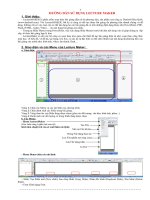Lecture dental ipn frcomp bridge
Bạn đang xem bản rút gọn của tài liệu. Xem và tải ngay bản đầy đủ của tài liệu tại đây (7.98 MB, 60 trang )
VẬT LIỆU NHA KHOA PHỤC HỒI
MẠNG LIÊN THẤM
và
Phục hình cố định bằng composite
tăng cường sợi thủy tinh bán liên thấm
NGND, GS BS Hoàng Tử Hùng
Website: www.hoangtuhung.com
THẾ GIỚI VẬT LIỆU
Trăm năm trong cõi người ta …
VÔ CƠ –
CERAMIC
Thế giới vật liệu (chỉ) có ba thứ này
KIM LOẠI
HỮU CƠ –
POLYMER
THẾ GIỚI VẬT LIỆU
large - particle
particle - reinforced
dispersion
strengthened
continuous
composite
fiber - reinforced
Composite nha khoa
Chốt sợi
aligned
discontinuous
laminates
structural
Phân loại theo pha tăng cường
sandwich panels
Randomly
oriented
Composite nha khoa ở đâu?
COMPOSITE
Nha khoa đang dùng những composite nào?
Matrix phase
Reinforcement phase
Polymer
Ceramic
Metal
polymer
Kevlar fibers in epoxy
5
Discontinuously Reinforced
Al (DRA):
brake components…
Polymer matrix
composite (PMCs)
Ceramic
Metal
2
[Pb2(picOH)4] H2O and
[Pb3(Sip)2- (H2O)2] H2O
3
co-continuous Al–
Al₂O₃ composites
4
Ceramic matrix
composite (CMCs)
1
Metal matrix
composite (MMCs)
COMPOSITE
Composite nha khoa ở đâu?
Matrix phase
Reinforcement phase
Polymer
Ceramic
Metal
polymer
Ceramic
Composite nha khoa
glassfiber
Kevlar fibers in epoxy
Composite nha khoa
`
glassfiber
?
Discontinuously Reinforced
Al (DRA):
brake components…
Polymer matrix
composite (PMCs)
Metal
?
[Pb2(picOH)4] H2O and
[Pb3(Sip)2- (H2O)2] H2O
?
co-continuous Al–
Al₂O₃ composites
?
Ceramic matrix
composite (CMCs)
?
Metal matrix
composite (MMCs)
24 – 5 - 2017
B&O PLAY Announce
World’s First
Beer Infused With
Music
Bia mà cịn … thì Vật liệu nha khoa thế nào?
Năm 1989, DOE* đã bảo trợ hội thảo khoa học của Hội Ceramic Hoa Kỳ tại Colorado
về những qui trình vật liệu ceramic và về đặc điểm cơ học của chúng, nhưng
rất nhiều qui trình đã được áp dụng như nhau cho các vật liệu ceramic, kim loại,
polymer và kết hợp cả ba
DOE: The U.S. Department of Energy
‒ tổng quan các hiểu biết về vật liệu có cấu trúc vi thể liên thấm,
‒ tìm kiếm các qui trình thích hợp để sản xuất composite pha liên thấm, và
‒ để nêu ra những câu hỏi nghiên cứu
* The U.S. Department of Enegy’s Division of Basic Energy Sciences (DOE-BES)
David R. Clarke: Interpenetrating Phase Composites, j.Am. Ceram. Soc., 75 [ 4 ]739-59 (1992)
COMPOSITE PHA LIÊN THẤM
Composite truyền thống là vật liệu có vi cấu trúc gồm:
- Một pha phân tán, rời rạc, và biệt lập
trong một pha khác, là…
- Pha khuôn (matrix) đồng nhất
Thí dụ: composite nha khoa
Những phát triển gần đây của khoa học vật liệu hiện đại đã cho phép khả năng
tạo ra có chủ ý vật liệu composite trong đó …
mỗi pha đều liên tục và xuyên thấm vào nhau ở mức vi cấu trúc
David R. Clarke: Interpenetrating Phase Composites, j.Am. Ceram. Soc., 75 [ 4 ]739-59 (1992)
Composite pha liên thấm được coi là composite đa pha
Trong đó, tồn bộ mỗi pha, về mặt cấu hình liên kết*,
kết nối với nhau** ở mức cấu trúc vi thể
interpenetrating phase composites = multiphase composites
* topologically
** interconnect
David R. Clarke: Interpenetrating Phase Composites, j.Am. Ceram. Soc., 75 [ 4 ]739-59 (1992)
Các vật liệu đa pha, trong đó các pha thành phần:
- liên tục với nhau, và
- kết nối với nhau theo ba chiều
composite pha liên thấm (interpenetrating phase composites - IPCs).
J. J. HARRIS, P. M. MARQUIS: Comparison of the deformation and failure characteristics of morphologically distinct metal-glass interpenetrating
phase composites, JOURNAL OF MATERIALS SCIENCE 37 (2002) 2801 – 2810
Các phương pháp chế tạo IPCs:
‒ Thấm nhập mao dẫn vật liệu độ nhớt thấp thành mạng lưới trong vật liệu lỗ rỗ
‒ Thấm nhập dưới áp lực
‒ Phương pháp phản ứng tại chỗ gồm:
‒ Phản ứng kim loại thấm nhập bằng cách thay thế oxyt chống ăn mòn
‒ Phản ứng tổng hợp tự lan dần dưới nhiệt độ cao
‒ Phản ứng ép nóng đẳng tĩnh
‒ Kỹ thuật phân hủy spinodal hệ thống pha glass tách biệt
(spinodal decomposition of phase-separated glass systems)
‒ Phương pháp tạo mẫu nhanh (in ba chiều)
J. J. HARRIS, P. M. MARQUIS: Comparison of the deformation and failure characteristics of morphologically distinct metal-glass interpenetrating
phase composites JOURNAL OF MATERIALS SCIENCE 37 (2002) 2801 – 2810
Key words:
Vật liệu nha khoa phục hồi
- Interpenetrating network material
vật liệu mạng liên thấm
- Resin infiltrated ceramic:
sứ thấm resin (thấm nhựa)
composite mạng liên thấm sứ-nhựa
M.V. Swain a, A. Coldea, A. Bilkhair, P.C. Guess: Interpenetrating network ceramic-resin composite dental restorative materials, dental materials 32 (2016 ) 34–42
Vật liệu nha khoa mạng liên thấm
(IPN based dental materials)
Từ khóa:
Slip cast: đúc rót
a liquid clay body slip is poured into plaster moulds and allowed
to form a layer, the cast, on the inside walls of the mould.
Connective neck: cổ nối
the continuous rearrangement in atomic configuration of the neck
Capillary force: lực mao dẫn
SỨ & IPN NHA KHOA HiỆN ĐẠI
- Ba loại sứ nha khoa
- Hai loại IPN
Cái Gì Đây?
Cái Gì Nữa Đây?
Vật liệu IPN Al₂O₃ - Thủy tinh
Vật liệu IPN ZrO₂/Al₂O₃- Nhựa
Vật liệu nha khoa mạng liên thấm (IPN based dental materials)
In-ceram®: Alumina thấm glass cho phục hình tồn sứ
2.1.1. In-ceram family of all-ceramic materials
The all-ceramic In-ceram group of ceramics, developed by
1989
Vita
Zahnfabrik
giớiago
thiệu
Sứ thấm thủybytinh
Sadoun
more
than 25 years
and commercialized
Vita In-ceram®
1989,
weremạng
the first
specific
dental
LàZahnfabrik
vật liệu in
nha
khoa
liên
thấm
đầumaterials
tiên to
the IPN concept. They also overcame the major
1-utilize
Đúc
rót hỗn hợp hạt alumina thô và mịn
obstacle associated with the use of all-ceramic systems
đạt
độ khoảng
70% . of ∼20% by the
namelymật
sintering
induced shrinkage
of a technique
that involved precision net shape
- development
Nung ở 1000
- 1200ºC:
forming. This consisted of utilising a combination of coarse
- fine
cóalumina
sự tạoparticles
thành that
cáccould
cổ nối
các
and
be giữa
slip cast
to hạt
approx.
70%
whichkhối
upon alumina
sintering tocấu
1000–1200
- density,
tạo thành
trúc lỗ◦Crỗdid not
shrink despite the formation of necks between the individual
- không bị co trong q trình thiêu kết
particles
do
hạtgrains
thơ
This was achieved by the presence
of có
the các
coarse
which prevented contraction and resulted in an open fine
Cấu trúc vi thể của In-ceram®
porous structure throughout the alumina body. Subsequent
2-infiltration
Thấm glass
950 - 1000ºC
lực mao
of thisởstructure
with glassdưới
at 950–1000
◦C, dẫn
whichđể tạo thành cấu trúc đặc chắc.
dùng
làm mão
cầu
ngắn
trước
completely
wettedvàand
under
therăng
influence
of capillary forces,
resulted in near completely dense structures.
M.V. Swain a, A. Coldea, A. Bilkhair, P.C. Guess: Interpenetrating network ceramic-resin composite dental restorative materials, dental materials 32 (2016 ) 34–42
Vật liệu nha khoa mạng liên thấm (IPN based dental materials)
Enamic: sứ thấm polymer (resin infiltrated glass-ceramic)
Năm 2012, việc dùng resin thay thế glass để thấm
2.1.2. Enamic, ceramic based resin infiltrated technology
vào
cấuoftrúc
lỗ rỗ glass
củaforAlumina
công với sự
The
concept
resin replacing
the infiltration thành
of
porous In-ceram structures had a long history before the successful
ra đời của
sản phẩm
development
and commercial
releaseEnamic.
of Enamic in 2012. The major
difference between the infiltration of a glass versus a resin was that
Khó khăn của thấm resin (so với thấm glass) là do
the curing shrinkages of the resin (∼5%[10]) were much greater than
the differential
shrinkage
upon
cooling
of the(5%
glass-ceramic
system
Sự
co
khi
trùng
hợp
so
với
<1% của glass)
(«1%). The stresses generated by the substantial shrinkage of the
curing resin and
the rigid
ceramic
frameworkhợp
generally
resulted
in resin khỏi
Ngẫu
lực
co trùng
làm
bong
debonding
between the khung
resin and framework
leadingvật
to greater
sứ và làm
liệuopacity
đụcbecause
of the interface gaps that developed. Judicious selection of resin,
silanation enhanced bonding between the resin and ceramic and high
pressure during the curing phase overcame the problems resulting in
a dense aesthetically appealing material. A typical example of the
microstructure of Enamic is shown in Fig. 1b. A study by FrancoSteier et al.[11] of resin infiltrated porous alumina ceramic frameworks
explored the role of pressure on the strength and such IPN systems.
Simultaneously Sadoun and students have investigated a range of
modified IPN resin infiltrated ceramic networks [8]
Sử dụng thêm silan để “dán” resin với ceramic
dưới áp suất cao
vật liệu chắc đặc, thẩm mỹ, ít gãy vỡ
Cấu trúc vi thể của Enamic
resin infiltrated glass-ceramic
M.V. Swain a, A. Coldea, A. Bilkhair, P.C. Guess: Interpenetrating network ceramic-resin composite, dental restorative materials, dental materials 32 (2016 ) 34–42
Ceramill Motion 2 ready for…
Vật liệu nha khoa mạng liên thấm (IPN based dental materials)
Captek (Davis Schottlander and Davis Ltd, Herts, UK)
Là hệ metal-metal IPC để làm sườn kim loaị
tỷ lệ vàng cao cho mão sứ porcelain
Chế tạo bằng cách thấm pha K.loaị thứ hai lỏng
vào pha K.loại thứ nhất lỗ rỗ
giảm sự co của kim loại khi nung sứ
Pha thứ nhất (“P material” Au-Pt-Pd) khi nung
tiền thể (preform) có chất gắn hữu cơ
Pha thứ hai (“G material”) gồm các hạt Au hình cầu,
khi nung
nóng chảy và thấm hút vào pha thứ nhất,
thế chỗ chất gắn hữu cơ
Cap-P
Cap-G
J. J. HARRIS, P. M. MARQUIS: Comparison of the deformation and failure characteristics of morphologically distinct metal-glass interpenetrating
phase composites, JOURNAL OF MATERIALS SCIENCE 37 (2002) 2801 – 2810
J. J. HARRIS, P. M. MARQUIS: Comparison of the deformation and failure characteristics of morphologically distinct metal-glass interpenetrating
phase composites, JOURNAL OF MATERIALS SCIENCE 37 (2002) 2801 – 2810









